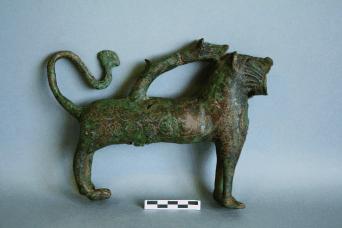Dating by Electrode

How can the age of archeological objects be determined if the well-established carbon dating method does not apply, for example for metal objects? Spanish and Portuguese scientists have now introduced a technique for dating artifacts made of copper and bronze. Presented in the journal Angewandte Chemie, their electroanalytical method is based on the voltammetry of microparticles. It compares various corrosion products that form over long periods of time and works with only a few nanograms of material so it causes almost no damage.
Voltammetric experiments produce current–voltage curves that have characteristic shapes for many compounds. In order to date copper-containing, archaeological finds, a team led by Antonio Doménech-Carbó at the University of Valencia examined the ratios of two different copper oxides, tenorite and cuprite, that can be differentiated and quantified based on their voltammetric curves.
When they are exposed to air, copper surfaces become covered by a natural layer of cuprite (Cu2O). Over time, this layer is slowly converted to other products of corrosion. As copper-containing objects age in a slightly corrosive environment, without contact with soils or sea air, a layer of tenorite (CuO) continuously forms over the primary cuprite patina. This occurs because cuprite reacts with oxygen from the air to preferentially form tenorite in an atmosphere containing CO2 or in the presence of calcareous materials. Examination of copper coins by scanning electron microscopy coupled with X-ray spectroscopy confirmed the presence of cuprite and tenorite.
To carry out the electroanalytical experiments, the researchers impregnate a graphite bar electrode with paraffin and dab the surface of the artifact with it. A few nanograms of the sample surface stick to the electrode, which is then dipped into an aqueous electrolyte. This causes almost no damage to the object. Copper oxide microparticles result in very characteristic peaks in the resulting current–voltage curves.
Of particular interest to the researchers is the ratio of the current peaks for tenorite and cuprite. It shows a steady increase with increasing corrosion time, as demonstrated with a series of antique coins from various collections, including the Prehistory Museums of València and Xàtiva (Spain), as well as the artificial ageing of Euro cent coins made of copper. The researchers were able to use the coins to establish a calibration curve that can be used to date objects of unknown age.
The voltammetric dating of a water pitcher from the Caliphal period and a Montefortino helmet from the Roman age gave ages of 1050±80 and 2150±150 years, respectively, which agree well with dates previously established from the archaeological context.
About the Author
Dr. Antonio Doménech-Carbó is Professor at the Department of Analytical Chemistry of the University of Valencia, Spain. His research field is electrochemistry, in particular focused on electroanalytical methods for archaeometry, conservation, and restoration of cultural heritage.
Author: Antonio Doménech-Carbó, Universitat de València (Spain), http://www.uv.es/uvweb/analytical-chemistry-department/en/administrative-technical-staff/organisation-chart-1285859984083.html
Title: Dating Archaeological Copper/Bronze Artifacts by Using the Voltammetry of Microparticles
Angewandte Chemie International Edition, Permalink to the article: http://dx.doi.org/10.1002/anie.201404522
Media Contact
All latest news from the category: Life Sciences and Chemistry
Articles and reports from the Life Sciences and chemistry area deal with applied and basic research into modern biology, chemistry and human medicine.
Valuable information can be found on a range of life sciences fields including bacteriology, biochemistry, bionics, bioinformatics, biophysics, biotechnology, genetics, geobotany, human biology, marine biology, microbiology, molecular biology, cellular biology, zoology, bioinorganic chemistry, microchemistry and environmental chemistry.
Newest articles

“Nanostitches” enable lighter and tougher composite materials
In research that may lead to next-generation airplanes and spacecraft, MIT engineers used carbon nanotubes to prevent cracking in multilayered composites. To save on fuel and reduce aircraft emissions, engineers…

Trash to treasure
Researchers turn metal waste into catalyst for hydrogen. Scientists have found a way to transform metal waste into a highly efficient catalyst to make hydrogen from water, a discovery that…

Real-time detection of infectious disease viruses
… by searching for molecular fingerprinting. A research team consisting of Professor Kyoung-Duck Park and Taeyoung Moon and Huitae Joo, PhD candidates, from the Department of Physics at Pohang University…





















